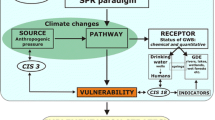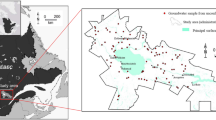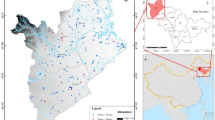Abstract
The Florida Aquifer Vulnerability Assessment (FAVA) was designed to provide a tool for environmental, regulatory, resource management, and planning professionals to facilitate protection of groundwater resources from surface sources of contamination. The FAVA project implements weights-of-evidence (WofE), a data-driven, Bayesian-probabilistic model to generate a series of maps reflecting relative aquifer vulnerability of Florida’s principal aquifer systems. The vulnerability assessment process, from project design to map implementation is described herein in reference to the Floridan aquifer system (FAS). The WofE model calculates weighted relationships between hydrogeologic data layers that influence aquifer vulnerability and ambient groundwater parameters in wells that reflect relative degrees of vulnerability. Statewide model input data layers (evidential themes) include soil hydraulic conductivity, density of karst features, thickness of aquifer confinement, and hydraulic head difference between the FAS and the watertable. Wells with median dissolved nitrogen concentrations exceeding statistically established thresholds serve as training points in the WofE model. The resulting vulnerability map (response theme) reflects classified posterior probabilities based on spatial relationships between the evidential themes and training points. The response theme is subjected to extensive sensitivity and validation testing. Among the model validation techniques is calculation of a response theme based on a different water-quality indicator of relative recharge or vulnerability: dissolved oxygen. Successful implementation of the FAVA maps was facilitated by the overall project design, which included a needs assessment and iterative technical advisory committee input and review. Ongoing programs to protect Florida’s springsheds have led to development of larger-scale WofE-based vulnerability assessments. Additional applications of the maps include land-use planning amendments and prioritization of land purchases to protect groundwater resources.






Similar content being viewed by others
References
Agterberg F. P., Bonham-Carter G. F., Cheng Q., and Wright D. F., 1993, Weights of evidence modeling and weighted logistic regression for mineral potential mapping, in Davis J. C., and Herzfeld, U. C. (eds.), Computers in Geology, 25 years of Progress: Oxford Univ. Press, Oxford, p. 13–32
Alberti, L., De Amicis, M., Masetti, M., and Sterlacchini, S., 2001, Bayes’ rules and GIS for evaluating sensitivity of groundwater to contamination: Proc. Intern. IAMG Conference 2001-Cancun, Mexico, unpaginated
Aller, L., Bennett, T., Lehr, J. H., and Petty, R. J., 1985, DRASTIC: A standardized system for evaluation of ground water pollution potential using hydrogeologic settings: U.S. Environmental Protection Agency, EPA/600/2-85/018, 63 p
Arthur, J. D., Cichon, J. R., Baker, A. E., Wood, H. A. R., and Rudin, A., 2003, The Florida Aquifer Vulnerability Assessment (FAVA) model: A tool for aquifer protection in karst settings (abst.): The 16th National Cave and Karst Management Symposium; http://www.nckms.com/abstracts.htm, last accessed 10 August 2006
Arthur J. D., Baker A. E., Cichon J. R., Wood H. A. R., and Rudin A., 2007, Florida, Aquifer Vulnerability Assessment (FAVA): Contamination potential of Florida’s principal aquifer systems: Florida Geol. Survey Bull. 67, in review
Baker A. E., Cichon J. R., Arthur J. D., Raines G. L., 2002, Florida Aquifer Vulnerability Assessment (FAVA) (abst.). Geol. Soc. America Abstracts with Programs, 34(6):346
Beck, B. F., and Jenkins, D. T., 1988, Potential for groundwater pollution of the Floridan aquifer, based upon surficial drainage, karst development, and, overburden characteristics: Florida Sinkhole Research Institute, Univ. Central Florida, Map Series 87-88-1, scale 1:250,000, 15 sheets
Bekesi G., McConchie J., 2000, Empirical assessment of the influence of the unsaturated zone of aquifer vulnerability, Manawatu region, New Zealand. Ground Water, 38(2):193–199
Bekesi G., McConchie J. A., 2002, The use of aquifer media characteristics to model vulnerability to contamination, Manawatu region, New Zealand. Hydrogeology Jour., 10:322–331
Berndt M. P., Oaksford, E. T., Mahon, G. L., and Schmidt, W., 1998, Groundwater, in Fernald, E. A., and Purdum, E. D., eds., Water Resources Atlas of Florida: Florida State Univ., Inst. Public Affairs, 312 p
Bonham-Carter G. F., 1994, Geographic Information Systems for geoscientists, modeling with GIS Pergamon Press, Oxford, 398 p
Cichon J. R., Baker A. E., Wood H. A. R., and Arthur J. D., 2005, Wekiva aquifer vulnerability assessment. Florida Geol. Survey Rept. Invest. No.104, 36 p
Connell L. D., van den Daele G., 2003, A quantitative approach to aquifer vulnerability mapping. Jour. Hydrology, 276(1–4):71–88
COST Action 65, 1995, Hydrogeological aaects of groundwater protection in karstic areas – final report: European Commission, Rept. EUR 16574 EN, Directorat-General: Science, Research and Development, Brüssel, Luxemburg, 446 p
Dixon, B., Scott, H. D., Brahana, J. V., Mauromoustakos, A., and Dixon, J. C, 2001, Application of neuro-fuzzy techniques to predict ground water vulnerability in northwest Arkansas: Arkansas Water Resource Center, Univ. Arkansas, Publ. No. PUB-183, 64 p
Doerfliger N., Jeannin P. -Y., Zwahlen F., 1999, Water vulnerability assessment in karst environments: A new method of defining protections areas using a multi-attribute approach and GIS tools (EPIK method). Environmental Geology, 39(2):165–176
Edet A. E., 2004, Vulnerability evaluation of a coastal plain sand aquifer with a case example from Calabar, southeastern Nigeria. Environmental Geology, 45(8):1062–1070
Ferguson, S., 2002, DRASTIC vs FAVA—A comparison of two available methodologies for aquifer protection in Florida: A case study in Orange County: unpubl. research paper, Florida State Univ., 67 p
Florida Department of Community Affairs (FDCA), Florida Department of Environmental Protection and 1000 Friends of Florida, 2002, Protecting Florida’s springs – land-use planning and best management practices, 124 p., http://www.dca.state.fl.us/fdcp/DCP/publications/springsmanual.pdf, last accessed 24, September 2006
Florida Natural Areas Inventory, 2006, Florida Forever Conservation Needs Assesment Tech. Rept., Version 2.1, 116 p., http://www.fnai.org/PDF/FF_CAN_technical_report.pdf, last accessed 5, October 2006
Florida Springs Task Force, 2000, Florida’s Springs, in Harnett, F. M., ed., Strategies for Protection & Restoration, 59 p. http://www.dep.state,fl.us/springs/reports/FloridaSpringsReport.pdf last accessed 10, September 2006
Focazio M. J., Reilly T. E., Rupert M. G., Helsel D. R., 2002, Assessing ground-water vulnerability to contamination: Providing scientifically defensible Information for decision makers. U.S. Geol. Survey Circ. v. 1224, 33 p.
Huaming G., Wang Y., 2004, Specific vulnerability assessment using the MLPI model in Datong city, Shanzi province, China. Environmental Geology, 45(3):401-407
Kemp, L. D., Bonham-Carter, G. F., Raines, G. L., and Looney, C. G., 2001, Arc-SDM: Arcview extension for spatial data modeling using weights of evidence, logistic regression, fuzzy logic and neural network analysis, http://www.ige.unicamp.br/sdm/defaultSDM e.htm, last accessed 4, October 2006
Kincaid T. R., Denizman C., Arthur J. D., Hazlett T., 2004, The Florida cave database: A GIS of underwater caves for hydrogeological characterizations (abst.). Geol. Soc. America Abstracts with Programs, 36(2):85
Landis J. R., Koch G. G., 1977, The measurement of observer agreement for categorical data. Biometrics, 33:159–174
Lawrence F. W., Upchurch S. B., 1982, Identification of recharge areas using factor analysis. Groundwater, 20(6):680–687
Marella R. L., 2004, Water withdrawals, use discharge, and trends in Florida, 2000: U.S. Geol. Survey Scientific Invest. Rept., v. 2004–5151, 50 p
Masetti M., Poli S., Sterlacchini S., 2005, Aquifer vulnerability assessment using weights of evidence modeling technique: Application to the province of Milan, northern Italy. Proc. IAMG’05. GIS and Spatial Analysis, 1:499–504
Masetti, M., Poli, S., and Sterlacchini, S., 2007, The use of the weights-of-evidence modeling technique to estimate the vulnerability of groundwater to nitrate contamination: Natural Resources Research, v.16, no.2, this issue, doi: 10.1007/s11053-007-9045-6
Merchant J. W., 1994, GIS-based groundwater pollution hazard assessment; a critical review of the DRASTIC model. Photogrammetric Engineering and Remote Sensing, 60(9):1117–1127
Murray K. S., Rogers D. T., 1999, Groundwater vulnerability, Brownfield Redevelopment and Land Use Planning. Jour. Environmental Planning and Management, 42:801–810
National Research Council (NRC), 1993, Ground water vulnerability assessment: Predicting relative contamination potential under conditions of uncertainty: National Acad. Press, Washington, 204 p
Navulur, K. C. S., Engel, B. A., and Mamillapalli, S., 1995, Groundwater vulnerability evaluation to nitrate pollution on a regional scale using GIS, in Applications of GIS to the Modeling of Non-Point Source Pollutants in the Vadose Zone, SSSA Spec. Publ. No. 48, ASA-CSSA-SSSA Bouyoucos Conference (Mission Inn, Riverside, CA) 20 p
Nolan, B. T., 2001, Relating nitrogen sources and aquifer susceptibility to nitrate in shallow ground waters of the United States: Ground Water, v. 39, no. 2, p. 290–299
Raines, G. L., 1999, Evaluation of weights of evidence to predict epithermal-gold deposits in the great basin of the western United States: Natural Resources Research, vol. 8, no. 4, p. 257–276
Raines, G. L., Bonham-Carter, G. F., and Kemp, L., 2000, Predictive probabilistic modeling using ArcView GIS: ArcUser, v. 3, no.2, p. 45–48
Ross, M., Martel, R., Lefebvre, R., Parent, M., and Savard, M., 2004, Assessing rock aquifer vulnerability using downward advective times from a 3D model of surficial geology: A case study from the St. Lawrence Lowlands, Canada: Geofísica Internacional, v. 43, no. 4, p. 591–602
Rupert, M. G., 1997, Nitrate (NO2+NO3–N) in ground water of the upper Snake River Basin, Idaho and western Wyoming, 1991-95: U.S. Geological Survey Water Resources Invest. Rept. 97-4174, 47 p
Rupert, M. G., 1999, Improvements to the DRASTIC ground-water vulnerability Mapping method: U.S. Geol. Survey Fact Sheet FS-066-99, 6 p
Sawatzky, D. L., Raines, G. L., Bonham-Carter, G. F., and Looney, C. G., 2004, ARCSDM3.1: ArcMAP extension for spatial data modeling using weights of evidence, logistic regression, fuzzy logic and neural network analysis. http://www.ige.unicamp.br/sdm/ArcSDM31/default_e.htm, last accessed 5 October, 2006
Scott. T. M, 2002, Florida’s springs in jeopardy: Geotimes, May, 2002, http://www.agiweb.org/geotimes/may02/feature_springs.html, last accessed 12 September, 2006
Scott, T. M., Means, G. H., Meegan, R. P., Means, R. C., Upchurch, S. B., Copeland, R. E., Jones, J., Roberts, T., and Willet, A., 2004, Springs of Florida: Florida Geol. Survey Bull. No. 66, 377 p
Soller, D. R., 1992, Applying the DRASTIC Model – a review of county-scale maps: U.S. Geol. Survey Open-File Rept. 92–297, 36 p
Stiber N. A., Small M. J., Fischbeck P. S., 1998, The relationship between historic industrial site use and environmental contamination. Jour. Air & Waste Management Assoc., 48(9):809–818
Stewart, I. T., and Loague, K., 2003, Development of type transfer functions for regional-scale nonpoint source groundwater vulnerability assessments: Water Resources Research, v. 39, no.12, SBH17
Southeastern Geological Society, 1986, Hydrogeological units of Florida: Florida Geol. Survey Spec. Publ. No. 28, 8 p
U.S. Census Bureau: State and County Quick Facts, 01-Feb-2005, 15:48:47 EST, http://www.census.gov
Witkowski A. J., Rubin K., Kowalczyk A., Różkowski A., Wróbel J., 2003, Groundwater vulnerability map of the Chrzanów karst-fissured Triassic aquifer (Poland). Environmental Geology, 44(1):59–67
Visit Florida Research, 2006, http://www.media.visitflorida.org/about/research/, last accessed 10, September 2006
Vogel, M., 2006, Good Migrations: Florida Trend, http://www.floridatrend.com/article.asp?id=5795, last accessed 24, September 2006
Winter T. C., Harvey J. W., Franke O. L., Alley W. M., 1998, Ground water and surface water—A single resource. U.S. Geol. Survey Circ. 1139:79
Acknowledgments
The authors are grateful for the constructive comments by reviewers of this paper: Richard Deadman, Florida Department of Community Affairs, Tim Hazlett, Hazlett-Kincaid, Inc., and Sam Upchurch, SDII Global, Inc. We are also thankful for invaluable input by the FAVA TAC, members of which are listed in Arthur and others (2007). Suggestions by Marco Masetti, Department of Earth Sciences, University of Milan, Italy also were helpful. Financial support for this project was provided by the Division of Water Resource Management, Florida Department of Environmental Protection, which administered funds originating from the U.S. Environmental Protection Agency, Source Water Assessment and Protection Program.
Author information
Authors and Affiliations
Corresponding author
Rights and permissions
About this article
Cite this article
Arthur, J.D., Wood, H.A.R., Baker, A.E. et al. Development and Implementation of a Bayesian-based Aquifer Vulnerability Assessment in Florida. Nat Resour Res 16, 93–107 (2007). https://doi.org/10.1007/s11053-007-9038-5
Received:
Accepted:
Published:
Issue Date:
DOI: https://doi.org/10.1007/s11053-007-9038-5




